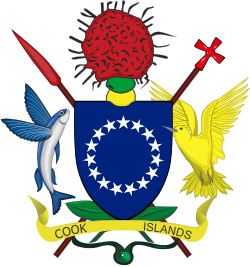| Coat of arms of the Cook Islands | |
|---|---|
 | |
| Versions | |
 Emblem of the Cook Islands Federation | |
| Armiger | Charles III in Right of New Zealand |
| Supporters | Flying fish (maroro) and white tern (kakaia) |
The coat of arms of the Cook Islands has a shield as its focal point. The shield is blue with fifteen white stars arranged in a circle, as found on the national flag, and is supported by a flying fish (maroro) and a white tern (kakaia). The helmet is an ariki head-dress (pare kura) of red feathers, symbolising the importance of the traditional rank system, and the name of the nation is on a scroll below the shield. The achievement is augmented by a cross and a Rarotongan club (momore taringavaru) used by orators during traditional discourses, respectively symbolizing Christianity and the richness of Cook Islands' tradition, placed in saltire behind the shield.[1]
The coat of arms was designed by Mataiapo Metuakore Teremoana Ngametua Tutakiao Kora BEM, also known as Papa Motu Kora.[1][2]
References
[edit]- ^ a b "Description of the Cook Islands Coat of Arms". Office of the Prime Minister, Cook Islands. Archived from the original on March 4, 2016.
- ^ Melina Etches (16 March 2021). "Coat of Arms designer Papa Motu Kora laid to rest". Cook Islands News. Retrieved 26 June 2024.
Well, that’s interesting to know that Psilotum nudum are known as whisk ferns. Psilotum nudum is the commoner species of the two. While the P. flaccidum is a rare species and is found in the tropical islands. Both the species are usually epiphytic in habit and grow upon tree ferns. These species may also be terrestrial and grow in humus or in the crevices of the rocks.
View the detailed Guide of Psilotum nudum: Detailed Study Of Psilotum Nudum (Whisk Fern), Classification, Anatomy, Reproduction